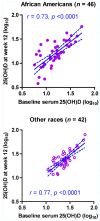Genetic associations with 25-hydroxyvitamin D deficiency in HIV-1-infected youth: fine-mapping for the GC/DBP gene that encodes the vitamin D-binding protein
- PMID: 24294218
- PMCID: PMC3827582
- DOI: 10.3389/fgene.2013.00234
Genetic associations with 25-hydroxyvitamin D deficiency in HIV-1-infected youth: fine-mapping for the GC/DBP gene that encodes the vitamin D-binding protein
Abstract
Serum 25-hydroxyvitamin D [25(OH)D] is often deficient (<12 ng/ml) or insufficient (<20 ng/ml) in youth living with human immunodeficiency virus type 1 infection (YLH). Based on evidence from multiple genome-wide association studies, we hypothesized that genetic factors associated with 25(OH)D deficiency should be readily detectable in YLH even when controlling for other known factors, including use of the antiretroviral drug efavirenz (EFV). Genotyping by bi-directional sequencing targeted 15 single nucleotide polymorphisms (SNPs) at the GC/DBP locus, with a focus on coding and regulatory variants, as well as those repeatedly reported in the literature. Three intronic SNPs (rs222016, rs222020, and rs222029) in a conserved haplotype block had unequivocal association signals (false discovery rate ≤ 0.006). In particular, the minor allele G for rs222020 was highly unfavorable among 192 YLH (99 African-Americans and 93 others), as gauged by relatively low likelihood for 25(OH)D sufficiency at enrollment (odds ratio = 0.31, p = 9.0 × 10(-4)). In a reduced multivariable model, race, season, latitude, body mass index, exposure to EFV, and rs222020-G were independent factors that collectively accounted for 38% of variance in the log10-transformed 25(OH)D concentration (p < 0.0001). Interaction terms were evident for rs222020-G × season (p < 0.001), latitude × season (especially fall and winter; p < 0.01), and race × EFV use (p = 0.024). Overall, variance in serum 25(OH)D is substantially attributable to multiple factors, but the exact contribution of genetic and non-genetic factors can be obscured by partial overlaps and frequent interactions.
Keywords: HIV-1; antiretroviral; genetics; race; vitamin D; youth.
Figures



Similar articles
-
Prevalence of vitamin D deficiency in women from southern Brazil and association with vitamin D-binding protein levels and GC-DBP gene polymorphisms.PLoS One. 2019 Dec 12;14(12):e0226215. doi: 10.1371/journal.pone.0226215. eCollection 2019. PLoS One. 2019. PMID: 31830090 Free PMC article.
-
Vitamin D Insufficiency/Deficiency in HIV-Infected Inner City Youth.J Int Assoc Provid AIDS Care. 2014 Sep-Oct;13(5):438-42. doi: 10.1177/2325957413495566. Epub 2013 Jul 23. J Int Assoc Provid AIDS Care. 2014. PMID: 23881908
-
The relationship between vitamin D status and HIV-related complications in HIV-infected children and young adults.Pediatr Infect Dis J. 2013 Nov;32(11):1224-9. doi: 10.1097/INF.0b013e318286c793. Pediatr Infect Dis J. 2013. PMID: 23360833 Free PMC article.
-
Change in vitamin D levels and risk of severe vitamin D deficiency over 48 weeks among HIV-1-infected, treatment-naive adults receiving rilpivirine or efavirenz in a Phase III trial (ECHO).Antivir Ther. 2014;19(2):191-200. doi: 10.3851/IMP2721. Epub 2014 Jan 16. Antivir Ther. 2014. PMID: 24430534 Clinical Trial.
-
Identification and analysis of 35 genes associated with vitamin D deficiency: A systematic review to identify genetic variants.J Steroid Biochem Mol Biol. 2020 Feb;196:105516. doi: 10.1016/j.jsbmb.2019.105516. Epub 2019 Oct 31. J Steroid Biochem Mol Biol. 2020. PMID: 31678109
Cited by
-
DBP rs16846876 and rs12512631 polymorphisms are associated with progression to AIDS naïve HIV-infected patients: a retrospective study.J Biomed Sci. 2019 Oct 23;26(1):83. doi: 10.1186/s12929-019-0577-y. J Biomed Sci. 2019. PMID: 31640710 Free PMC article.
-
Vitamin D in Human Immunodeficiency Virus Infection: Influence on Immunity and Disease.Front Immunol. 2018 Mar 12;9:458. doi: 10.3389/fimmu.2018.00458. eCollection 2018. Front Immunol. 2018. PMID: 29593721 Free PMC article. Review.
-
25(OH)D2 half-life is shorter than 25(OH)D3 half-life and is influenced by DBP concentration and genotype.J Clin Endocrinol Metab. 2014 Sep;99(9):3373-81. doi: 10.1210/jc.2014-1714. Epub 2014 Jun 2. J Clin Endocrinol Metab. 2014. PMID: 24885631 Free PMC article. Clinical Trial.
References
Grants and funding
LinkOut - more resources
Full Text Sources
Other Literature Sources
Molecular Biology Databases
Miscellaneous

